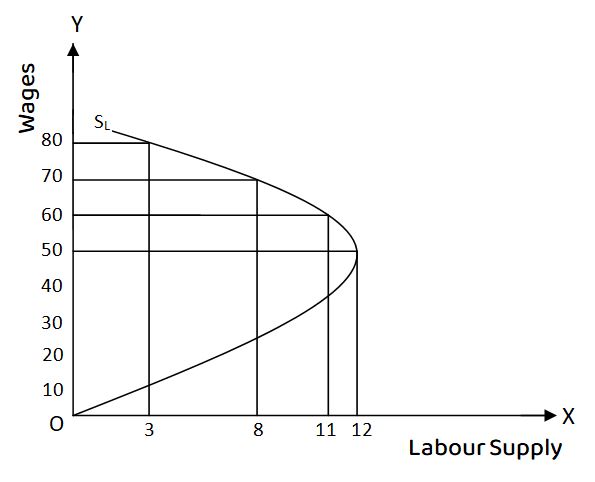Explain why the individual supply curve of labour is backward-bending.
The curve we draw on the supply of labour combining the income effect and the substitution effect of increase in wages is called the supply curve of labour.
The shape of a worker’s labour supply curve can be explained by the income effect and the substitution effect of an increase in wages.
Income Effect
At first, an increase in wages in wages may encourage a worker to work more upto a point. But finally there is a situation when the worker does not want to work further despite getting extra wages. Because then the increase in income is what motivates the worker to take rest- not to work anymore. This is called the income effect of increase in wages on labour supply. At first, the income effect is positive but after a stage it becomes negative.
Substitution Effect
On the other hand, when there was initially an incentive to work more with an increase in wages, the incentive to take more work rather than rest in anticipation of higher wages was effective and thereby increased the supply of labour. But now that wages have risen, labour time has been replaced by rest. This phenomenon is called the substitution effect of increases in wages.

In the above diagram, the OY axis represents wages and the OX axis represents labour supply. As long as the wage increases from Rs. 10 to Rs. 50, the supply of labour increases. But when the wage goes above Rs. 50, the supply of labour is no longer increasing. Rather, if the wages increase from Rs. 50 to Rs. 60 or Rs. 60 to Rs. 70, the supply of labour decreases. In this diagram, SL is the individual labour supply curve. The worker’s labour supply curve initially slopes upward to the right i.e. if the wage increases, the supply of labour increases. Again, after a certain point, the curve slopes upward to the left, meaning that as wages rise, the supply of labour falls.
Thus, it appears that the labour supply curve is mainly dependent on changes in the wage rate. Backward-bending supply curve implies that after a certain point, even an increase in wages cannot increase labour supply.
Liked our post?
We are available with lots and lots of commerce-related content.





[…] Individual Supply Curve of Labour […]
[…] Answer: Click here […]